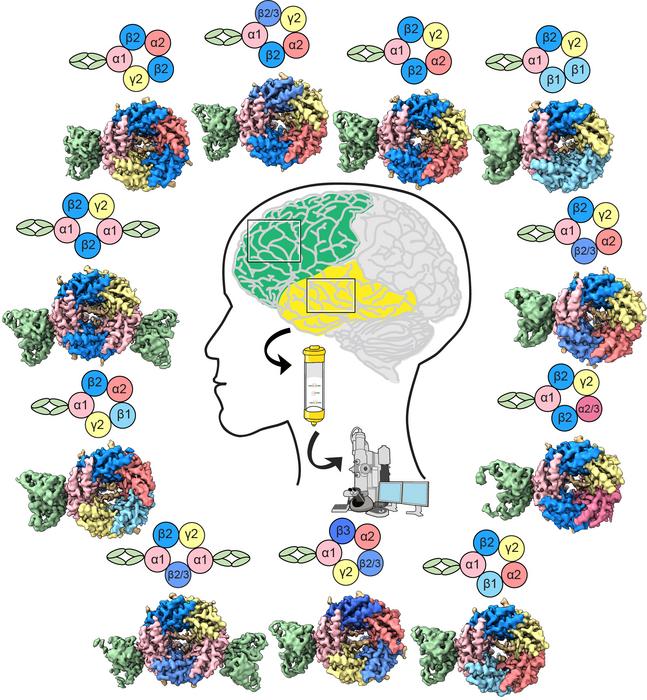
In a groundbreaking study, researchers from UC San Diego and the University of Texas Southwestern Medical Center have unveiled the intricate structural complexities of GABAA receptors, an essential component of neurotransmission in the human brain. These receptors are critical for regulating neuronal communication and have been linked to various neurological disorders, including epilepsy and anxiety. Their recent findings, published on January 22, 2025, in the highly esteemed journal Nature, represent a pioneering effort to provide a comprehensive understanding of these complex proteins directly from human brain tissues during surgical procedures.
GABAA receptors, being pivotal in controlling the flow of chloride ions into neurons, act as the brain’s inhibitory mechanisms. This functionality means they play a vital role in modulating neuronal excitability and maintaining the overall balance of signaling within the central nervous system. However, prior to this research, there existed significant gaps in understanding how these receptors’ various subunits, which number up to 19, physically assemble and interact with pharmacological agents prescribed for treating a range of neurological disorders.
To tackle this challenge, the research team led by Jia Zhou utilized advanced cryo-electron microscopy (cryo-EM), a cutting-edge imaging technique that freezes biological samples at ultra-low temperatures. This process preserves the delicate structures of proteins, allowing for high-resolution visualization and detailed mapping of receptor assemblies. Previous studies primarily relied on simplified models and extrapolation from animal studies, which limited scientists’ understanding of the exact structural configurations and functions of human GABAA receptors.
Addressing this gap, the researchers obtained human brain tissue samples from epilepsy patients during surgeries that necessitated the removal of problematic brain segments. Their consented donation of tissue allowed for both ethical research and unprecedented access to the kind of material needed to explore the intricate biology of these receptors in ways that were previously unattainable. The collaboration between UC San Diego and the University of Texas brought together a multidisciplinary team skilled in neurobiology, molecular biology, and structural biochemistry, guided by Professor Ryan Hibbs, a seasoned expert in receptor structure and function.
Analyzing the tissue samples at the newly established Goeddel Family Technology Sandbox, the research team meticulously examined the GABAA receptors under the electron microscope. The advanced imaging revealed a startling diversity in how the receptor subunits can assemble, creating a multitude of receptor configurations, each with distinct pharmacological properties. This discovery underscores why certain drugs may work effectively on some patients while failing on others, due to the specific receptor conformations they may engage with.
The significance of this research extends beyond the sheer technical achievement of imaging human brain proteins. It also presents profound implications for the development of targeted therapies for various neurological conditions. For instance, understanding how different subunit combinations impact receptor function opens the door to personalized medicine approaches for treating epilepsy and other disorders associated with GABAA receptor dysfunction. The researchers have reported already identifying novel functions for existing epilepsy medications, previously unknown to have interactions with these receptors, which may enable more effective treatment strategies.
Drilling deeper into the pharmacological implications, Zhou and colleagues have started to demystify how existing drugs work at the molecular level, thus creating a knowledge foundation for future drug discovery. By characterizing the interactions between GABAA receptors and therapeutic compounds, this work enlightens the process of designing next-generation medications that can precisely target the right receptors, potentially reducing side effects while enhancing efficacy. This aspect is particularly crucial in the context of treating multifaceted disorders like anxiety and depression, which engage multiple neurotransmitter systems, including GABAergic signaling.
Moreover, the collaborative approach to research, merging insights from biochemistry, neurobiology, and pharmacology, illustrates the power of multidisciplinary studies in unraveling complex biological problems. As the team continues its exploration of the diverse GABAA receptor subunit combinations across various brain regions, they plan further research that may extend into the realm of customizing treatments for individuals based on their unique receptor configurations. This approach aligns seamlessly with the growing movement towards personalized medicine in neurology, focusing on patient-centered therapies rather than one-size-fits-all solutions.
The challenges faced in studying human brain tissues are substantial, given the inherent delicacy and complexity of the biological material. Yet, the successful application of state-of-the-art techniques such as cryo-EM has proven that even with these hurdles, significant scientific advancements can still be made. Educational institutions that prioritize research infrastructure, like UC San Diego, play a critical role in generating breakthroughs that enhance our understanding of fundamental biological processes.
In conclusion, the findings from this study don’t just fill a crucial knowledge gap; they ignite a spark for further investigations into Neuronal communication and its implications for human health. As the researchers refine their methodologies and deepen their understanding of GABAA receptors, they place themselves at the forefront of neuroscientific research, with the potential to revolutionize how we approach treatment for a plethora of brain disorders. The ramifications of this research suggest that the next decade could see a significant transformation in the landscape of pharmacology for neurological conditions, much needed in our ongoing battle against mental health issues.
With ongoing studies aimed at exploring specific neurological conditions and individual patient responses to therapies, the realization of tailored treatments inevitably feels closer. As our understanding of the human brain advances, powered by innovative technologies and collaborative research, the quest for breakthroughs in neuroscience intensifies, reflecting an ever-increasing commitment to improving and enhancing the quality of life for millions.
Subject of Research:
Article Title: Resolving native GABAA receptor structures from the human brain
News Publication Date: 22-Jan-2025
Web References:
References:
Image Credits: Credit: Jia Zhou, Hibbs Lab, UC San Diego
Keywords
Tags: cryo-electron microscopyepilepsy researchGABA-A receptorshuman brain tissueneurological disordersneuronal excitabilityneurotransmissionPersonalized Medicinepharmacological interactionsreceptor subunit assemblystructural biologytargeted therapies





